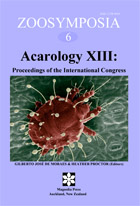Abstract
The Pedregal de San Ángel Ecological Reserve (REPSA) is located in the central campus of the Universidad Nacional Autónoma de México (UNAM), in México City. Diversity and abundance of edaphic mites of the order Mesostigmata were estimated in two sites of REPSA. One site had scanty vegetation, due to human alterations, and was designated as “open site” (O), whereas the other had less altered, denser vegetation, being designated as “closed site” (C). Samples of soil and litter collected during the rainy and dry seasons of 2008 were processed for the extraction of mites of that group, which were then mounted and quantified by morphospecies. Mite abundance was much higher in site O, but the number of morphospecies was about the same in both sites. The same mite families were found in both sites. For each season and for both seasons considered together, Shannon diversity and Pielou´s evenness indexes were significantly higher in site C. Sörensen similarity coefficient between sites was high in both seasons, but higher in the dry season; considering both seasons together, similarity coefficient between sites was 94%. This indicates that anthropogenic alteration of the vegetation at REPSA, reducing the height of the vegetation and turning it less dense, was not sufficient to cause major alterations in Mesostigmata species composition.

